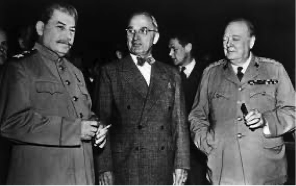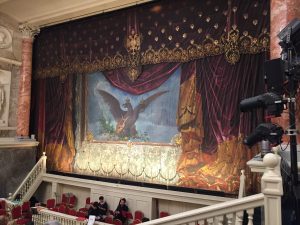After one of the most devastating and costly wars that the world has ever seen, the Allied Powers set out to accomplish specific goals after the war. These included bringing justice to Germany and the power of the Axis, along with necessary reparations that would restore balance to the globe, after the war.
For the war crimes that Germany had committed and the massive cost that they imposed on the allies in terms of both life and the cost of the war imposed on each nation that participated.
Conferences After World War II
The Potsdam Conference was held after the war from July through August of 1945. The US’s goal in the conference was to implement the Morgenthau Plan, developed by Henry Morgenthau Jr., who was the United States Secretary of the Treasury at the time.
During this famed conference is when the United States made the elective decision to dismantle the German armed forces and to strip them of all of their munitions factories, along with any other civilian-led industries that had a link to supporting their troops during the war.
This elaborate and comprehensive plan also included the total destruction of the ships involved in their navy and their aircraft and aircraft manufacturing plants and capabilities. The US also placed heavy restrictions on any and all types of civilian industries that could even possibly support the German armed forces, to keep the German military and economy at bay.
The Allies stripped down German industry and manufacturing to what they referred to as “approved peacetime needs” which were based on the standard of other European countries. They also reviewed the German industry closely to assess the minimum of factories that Germany would need to stay somewhat economically sufficient.
Industry Plans for Germany After World War II
The Allied powers signed the first level of industry plan back in late March of 1946. This plan would execute lowering Germany’s manufacturing and industrial capabilities by 50%, from what it was before the war. To do this, the allies mandated the destruction of 1,500 German manufacturing facilities.
The Allied Control Council put a stringent cap that limited German steel production down to 25% of what they were before the war broke out. Since this had a direct impact on the entire steel production capabilities of the UK, they argued to let Germany keep their steel production higher, but the US, Soviet Union, and France didn’t budge on this issue. They had set a strict limit to 3 million tons of steel production per year.
With the limitations that were placed on Germany after the war, this brought their economy back to the state that they had been at the worst of the Great Depression. The allies set out to cripple or limit the German economy as much as necessary, without providing a hindrance to the survival and standard of living to the German people.
William Henry Draper Jr. led the charge on analyzing these restrictions as to make sure that the new German industry and economy could support a population of 66.5 million. To do that, he laid out that the nation needed to be dependent on large imports of raw materials and food from other countries, so that the German people could be fed and take care of their minimal standards of living.
This also required Germany to shift economic terms, and instead of thriving on an economy fueled by war exports, these mandates made restrictions on the goods that Germany would export. It led them to being restricted to exporting electrical gear, coke, leather goods, coal, wines, spirits, beer, textiles, clothing and apparel, toys, and musical instruments.
The Results of the Morgenthau Plan
By 1946, the allies came to find that their implementations from the Morgenthau Plan were strict, and throttling the German people and their economy. With the allies taking notice of the undue hardships that this was placing on their country, they changed their stipulations to allow for some German economic expansion.
One of the primary reasons it is thought that the US changed their restrictions on Germany is because Germany was footing the bill for a significant piece of the occupation costs, of their country. Though, the limitations on the German economy inevitably left the allies relying on their own exports and funding to continue their occupation of Germany and prevent mass starvation during their post-war occupation.
The war and the end of the war took a massive role on the entire European economy. Prior to the war much of Europe was growing because of the booming growth of the German economy.
In 1947, President Harry Truman began to realize that the restrictions that the allies had placed on the German economy were far too strict, and the ramifications of that were crippling the entire European economy. Though he faced resistance to make changes to their original economic regulations, President Truman replaced their previous holds with JCS 1779, which addressed that the economic growth and stability of Europe as a whole was heavily reliant on the success of the German Economy. In accordance, he raised the bar on their regulations by allowing Germany to produce double the amount of steel that they were producing, though that limit was still only 50% of Germany’s pre-war steel production capacity.
Great Britain
Great Britain and the UK reaped the benefits of taking many German patents, intellectual property, and pieces of technology. They took German technicians and scientists captive after the war, threatening to keep them as prisoners if they did not reveal their trade secrets.
France
The US permitted France to expand their borders of the Saarland, which gave them access to German coal as a means to stimulate the post-war french economy.
By 1949, the Germans felt that they had suffered enough and called for an end. They felt that they had paid their dues and were fed up with the tug of war the allies were playing with them in encouraging economic expansion, while tearing down and limiting their production of factories and raw goods in which would help the economy. France was in support of the dismantling of Germany to continue.
The Post War Soviet Union
The reparations to the Soviet Union after the war included the shipments of dismantled German industrial equipment. From The end of March of 1946 to August of 1947, the Soviet Union had taken in 11,100 tons of German equipment.
In return, the Soviet Union was to ship food and wood to the western zones of Germany to aid in their survival and economic stability. However, the Soviet Union fell short on their end of the bargain, and in response the US but a temporary hold on the shipments of German industrial materials to the Soviet Union.
United States
The United States government set out with some very specific goals after the end of the war. Much of their strategy had to do with supporting their allies while making sure that justice was brought to the Axis.
The Allies in the west became concerned of the economic deterioration and fallout in the Trizone ––– the zones in Germany occupied by the Americans, British, and French after the war ––– after the war had ended. The US outlined the Marshall Plan which provided for financial aid to Europe, extending through Western Germany. This, along with a currency reform that they implemented in 1948 would help curb rampant inflation and provide some financial stability in the region.
The United States made it a priority to seize the patents and scientific technology that was being developed in Germany at the time. It is estimated that the US alone took around $10 billion in the form of German intellectual property. Most of this was split between the US and the UK.
The End of the Dismantling of Germany
Dismantling of the West German economy and their industry officially ended in 1951, but some restrictions stayed in play until the Allied occupation of West Germany came to an end in May of 1955.
https://en.wikipedia.org/wiki/Allied_plans_for_German_industry_after_World_War_II


